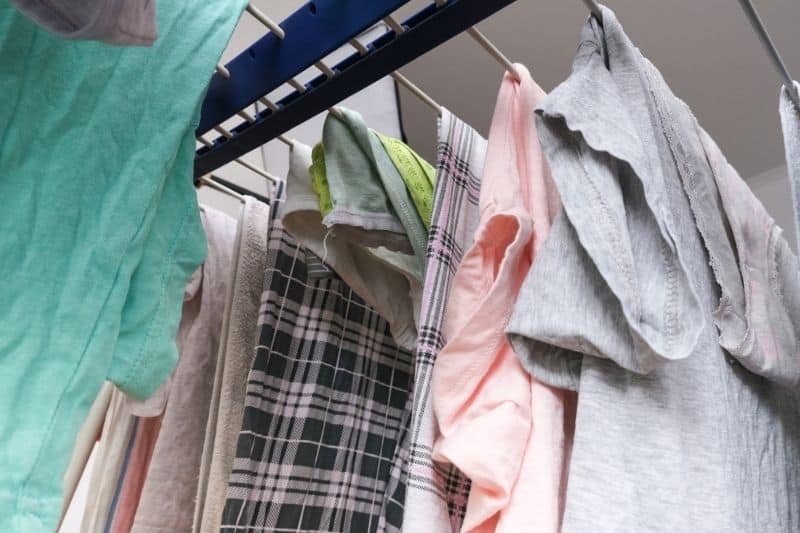When the winter weather forces us to dry the laundry indoors it can often be a bit of a pain, especially if you don’t own a tumble dryer and your space for drying clothes is limited.
Experts often advise against drying laundry inside your home but when the weather is uncooperative you don’t really have much choice.
There are a variety of ways you can successfully dry your clothes indoors while at the same time avoiding disturbing the indoor climate too much. Keep reading to discover tips and tricks to dry your clothes indoors.
Before Your Laundry Comes Out
There are a couple of things you can do during the washing process to help to shorten the time spent drying clothes on a rack.
1. Plan Ahead
Pay close attention to the weather forecast and plan to do the laundry on the days when the weather is the best and (at least some) sunshine is expected. It might take some careful planning but it will make drying your laundry a smooth process since you will have the sunshine on your side and the opportunity to open the windows.
2. Create a System
The winter season demands dressing in layers. It’s best to wash the lighter layers together since they will dry on the rack quicker than thicker items. This process will help you complete more loads of laundry in a small amount of time compared to mixing the fabric densities. This tip might take some creative thinking but typically separating the lightweight clothing from the heavier fabrics in separate bins gets the job done easily.
If you have a large family, have each member separate their laundry as they go along to save time. When using this technique it’s best to wash the lighter layers first since they dry quicker.
3. Don’t Overfill Your Washing Machine
Ensuring your laundry has enough space to move around during the wash cycle can help to reduce the amount of water remaining in your clothes at the end of the spin cycle. So try not to overfill your washing machine by bunging too many winter jumpers in at once, or you could end up with soggy clothes that will take hours of drying.
4. Add a Spin Cycle
Extra thick items such as towels, bedding, jeans, and bulky sweaters often take the longest to dry on the rack. So by adding an extra spin cycle to your routine, you could cut down drying time by a decent chunk.
Once the usual wash cycle has completed, you can check to see if the load needs another spin by touching a few of the items. If there are items that already feel pretty dry, take these out and let heavier items have another round in the drum.
The spin cycle helps your laundry to release excess water and is often just another 10 or so minutes to run but could cut down drying times by a lot more.
You could also give your clothing an extra wring out over the kitchen sink to release trapped water in the fabric, but do take care with more delicate or stretchy fabrics, as this could lead to misshaped items.

Time to Dry
Once your laundry is out of the washing machine, it’s time to get it dry. If you have a tumble dryer, this is the perfect way to get your clothes dry during the winter months, but if you don’t you may have to find a place to hang it indoors.
Many people opt to use a drying rack (or clothes airer) which can be placed anywhere in the home and some may even have indoor washing lines set up for winter or those rainy days (of which there are plenty in the UK). However you choose to dry your laundry, it is recommended that you don’t hang things directly on top of your radiators as this can be really bad for condensation, damp and could even release VOCs into the air (volatile organic compounds – can cause respiratory issues or agitate existing ones).
Here are some of our tips for drying clothes in the winter without damaging your home.
Place the Rack in the Right Place
Many people place the drying rack in the bedroom or living room but this sometimes leads to mould and mildew building up in these rooms. All of the soft furnishings in your bedroom or living room will end up absorbing moisture from the air which could lead to a nasty foisty smell… not what you want in your home.
A better place for the drying rack is in the bathroom, utility, kitchen or hallway.
- The bathroom is, obviously, already designed to withstand moisture, with tiled surfaces and often even an extractor fan of some sort.
- Utility rooms can also be an ideal spot for drying clothes too because they are out of the way and many people use this space specifically for laundry.
- If you can’t dry clothing in the bathroom for any reason and if you don’t have a utility room, the hallway (if large enough) or kitchen would be the next best thing. Kitchens are often the largest in the home leaving more room for drying laundry and, like bathrooms, often have tiled or hard-wearing surfaces to withstand excess moisture.
Installing a wall-mounted drying rack is ideal for creating more floor space and making drying clothes indoors much more convenient.

Small flats and homes usually have minimal space for a drying rack. You might need to move some of the furniture in a room around to accommodate the drying rack during the winter season. It’s best to choose a room or area of your home that doesn’t experience a lot of traffic.
Find the Hotspot in Your Home
Allow the sunshine to help dry your clothes indoors whenever possible. If you have a window in your home that allows the sun to shine in and heat the room, this is a great place to put the drying rack.
A portable rack is recommended to make it easier to turn around to ensure all the clothing receives some type of sunshine and warmth. This technique is one of the quickest ways to dry clothes indoors.
QUICK TIP: Take items off the rack intermittently to give them a good shake – this will not only create air-flow but could help to remove crinkles and decrease your ironing times too!
Protect Your Floors
Sometimes water from the clothing drips onto the floor which leads to damage. You can protect your flooring by placing plastic reusable material under the clothing rack. The plastic surface protects your flooring and is easy to clean afterward to prevent bacteria buildup. Use an antibacterial detergent to clean the plastic to ensure any bacteria is destroyed.
Allow Fresh Air Into Your Home
Wet clothing holds water that evaporates into the air in your home causing a change in the indoor climate. An extra spin in the washer helps lessen the amount of water evaporation but it’s also important to air the room out by opening the window.

The best time of the day to open the window is when the sun is the hottest. The clean dry winter air will balance the moisture in the room and prevent mould and bacteria from forming.
Prevent Allergies
Many people have allergies to mould which leads to sneezing and sinus discomfort. You can prevent allergies by using only one designated area of your home to dry laundry and immediately opening the window during or after the wet laundry is placed on the rack. Isolating the wet laundry to one room helps prevent allergies and makes it easier to clean and disinfect the area to prevent the development of mould.
Use a Dehumidifier
If you can’t utilise sunlight and opening your windows isn’t an option, then investing in a dehumidifier is a great way to ensure that all the excess moisture from your clothes doesn’t cause any problems in your home. Dehumidifiers come in all sizes, so you’re sure to find one to suit your living space and needs.
Benefits of Drying Your Clothes Indoors
- You don’t need to go outside in the cold weather
- It can be an easier process compared to going outdoors
- You don’t need to worry about harsh weather conditions
- You can allow your clothes to dry on the rack while you leave the house
- You don’t need to worry about sudden snowstorms or rain ruining your clothes
- It’s convenient
If you are still keen to dry your clothes outside in the winter, then here’s a post all about that.
Overall, drying your clothes indoors in the winter is an easy, convenient, and smooth process. The tips mentioned above will help you dry your clothes indoors while at the same time preventing mould, bacteria, and changes to your indoor climate.
Get started using these tips on your laundry today and have a great winter!

In The Wash is your guide to the best laundry and cleaning products, tips and tricks. Our mission is to solve the UK’s cleaning and laundry dilemmas!






